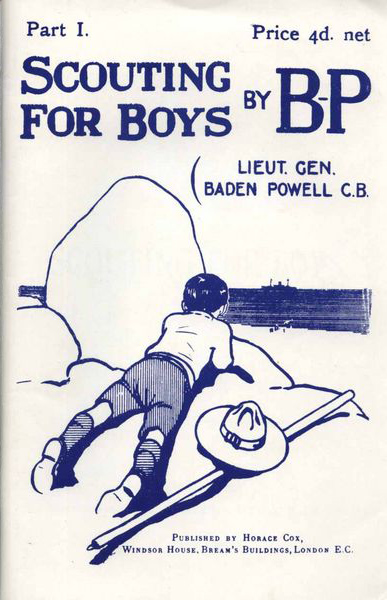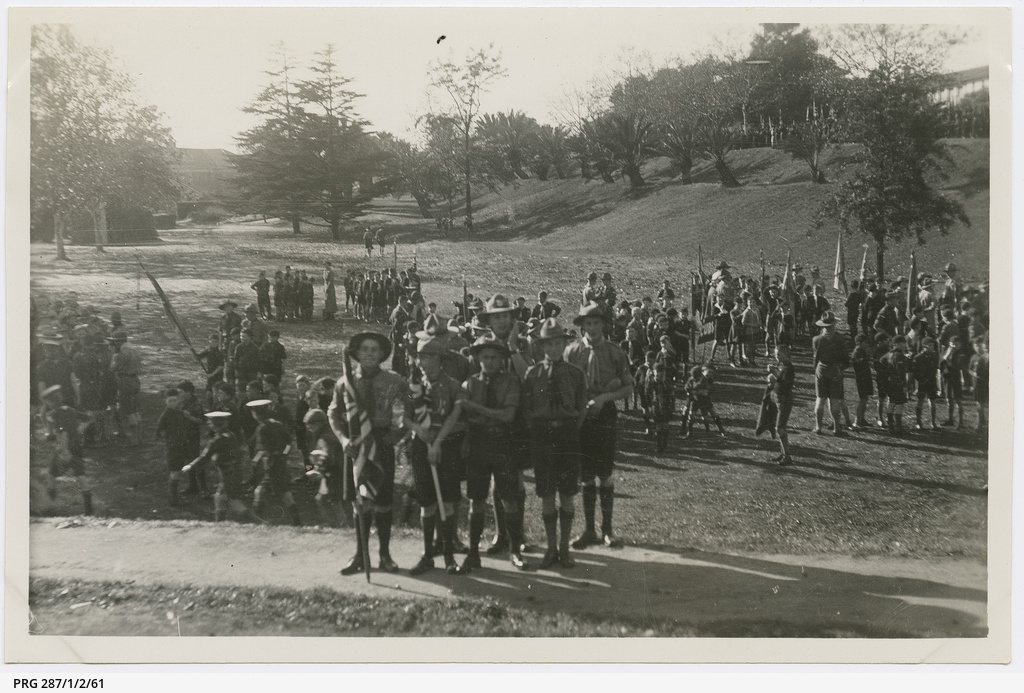Scouting in Campbelltown
History of Scouting
Scouting was born of an idea by an eminent long serving soldier, Lord Robert Baden-Powell. Born in England in 1857, as a boy he was adventurous and enjoyed open air pursuits with his brothers on land as well as in their boats.
His idea was that by educating youth about world peace an understanding can be achieved. From this idea scouting may be thought of as the world’s “first and biggest peace movement”. Scouting worldwide today has a membership of something over 250 million people either currently in the movement or have been in the past.
He entered the army via a scholarship and was sent to India where he served for many years. He began training soldiers in his “scouting” methods with the idea that it would be advantageous to them. It was at this time that he produced a book “Aids to Scouting” (1899) which was a much used text book over many years. The book “Scouting for Boys” (1908) was a re-write of the earlier book “Aids to Scouting”.

By Robert Baden-Powell, 1st Baron Baden-Powell, lieutenant-general in the British Army, writer, founder and Chief Scout of the Scout Movement (1857-1941) - per above, Public Domain, Link
As a soldier, BP rose to public prominence during the Boer War at the end of the 1800s. He returned to England in 1899 as a national hero for leading the defending force in the siege of the South African town of Mafeking.
Baden Powell organised an experimental camp in 1907 at Brownsea Island off the Dorset Coast. Boys lived in tents and cooked their own food as well as learning many valuable skills through games. Camps over the years have become a very popular and successful part of the scouting experience.
Boys formed scout patrols and troops and following Baden-Powell’s retirement from the army he devoted his life to the movement. A rally at Crystal Palace, London at this time drew together 10,000 boys.1
Girl Guides South Australia (GGSA) was established in 1912 and today it is the largest youth organisation for girls and young women in South Australia; with 2000 youth members and 500 volunteer Leaders and adult Members.2
After the establishment of Girl Guides in quick succession came the Sea Scout Branch in the same year, Wolf Cubs in 1916, Rover Scouts in 1918 and the Special Test (now "Extension") Department in 1926. The Group system of Cub Scouts, Scouts and Rovers under the leadership of the Group Scoutmaster was established in 1927, Deep Sea Scouts in 1928, Air Scouts in 1941 and Senior Scouts in 1946 (now known as Venturer Scouts).
Meanwhile Scouting spread to Australia, New Zealand, and India in 1908 and other countries followed shortly after.
Scouts Australia's South Australian Branch has 11 districts - Adelaide Foothills, Beadell, Heysen, Hills to Coast, Karkhana, Limestone Coast, Mawson, Ridley, Three Rivers and Torrens. There are also Lone Scouts for youth too far away from a regular meeting place.
Scouting in South Australia is now predominantly represented by Scouts Australia's South Australian Branch and the Girl Guides South Australia, a member organisation of Girl Guides Australia.3
Scout groups/troops in Campbelltown area:4
Listed below are the Scout Troops and Groups established in Campbelltown. However the Cub Packs, Venturers, Rovers, (Sea) Cub Packs, Sea Scout Troops, Senior Sea Scout Troops, Rover Sea Scouts are not listed individually but are covered within the Groups listed.
- Athelstone 1st Scout Troop registered 31/5/1966
- Athelstone 1st Scout Troop No. 2 registered 18/6/1974
- Athelstone 1st Group – still active 2020
- Glen Roy 1st Scout Troop registered 16/2/1925
- Glen Roy 1st Scout Troop in recess 18/4/1933
- Glen Roy 1st Scout Troop re-registered 15/4/1936
- Glen Roy 1st Scout Troop in recess 15/4/1937
- Glen Roy 1st Scout Troop re-registered 15/4/1939
- Glen Roy 1st Scout Troop in recess 15/4/1947
- Glen Roy 1st Scout Troup re-registered 22/3/1949
- Glen Roy 1st Scout Troop No. 2 registered 10/7/1973
- Glen Roy 1st Scout Group still active 1975
- Glen Roy 1st Scout Group not active 2007
- Hectorville 1st Scout Troop registered 18/2/1958
- Hectorville 1st Senior Scout Troop registered 27/3/1962
- Hectorville 1st Scout Group still active 1986
- Hectorville 1st Scout Group not active 1995
- Magill 1st Scout Troop forming 26/4/1914
- Magill 1st Scout Troop registered 21/7/1931
- Magill 1st Scout Troop in recess 15/4/1945
- Magill 1st Scout Troop re-registered 1/4/1947
- Magill 1st Scout Troop in recess 15/4/1951
- Magill 1st Scout Troop re-registered 15/4/1956
- Magill 1st Scout Group still active 2020
- Newton 1st Scout Troop registered 30/11/1965
- Newton 1st Scout Group still active 1985
- Newton 1st Scout Group not active 1995
- Stradbroke 1st Scout Troop registered 24/9/1963
- Stradbroke 1st Scout Group still active 2020
- Tranmere Scout Group still active 2015
- Tranmere Scout Group not active 2020
1st Magill Scout Group
The 1st Magill Scout Group appears to be the earliest troop of Boy Scouts formed in the District of Campbelltown, with the possible exception of the short-lived 1st East Adelaide Troop, formed in October 1909, which met at Magill, before relocating to the College Park Congregational Church.

The newly-formed troop met for the first time on Tuesday, 7th July 1914 at the Magill Institute when a lecture was given to the boys on the duty, privileges, and the pleasures of scouting. Scoutmaster R. A. Tritton was in charge of the troop. Twelve scouts were present at the initial meeting. Campbelltown Council purchased Nightingale Reserve, Woodforde Road, Magill, S. Aust., in 1956. The 1st Magill (St George’s) Scout Troop was granted permission to build a Scout Hall on the eastern extremity of the reserve in 1958, and construction was completed in 1960.
As at 2020 some of the activities Magill group are involved in are – e.g. a pets’ night, water games night; tie dying T-shirts, night hike to Black Hill, water safety at Burnside Pool. The Group joined other units for Clean Up Australia Day, 13 Scouts attended Group Camp at Roonka, navigation night and ice skating at the Ice Arena on the last night of term. Campbelltown Council invited representatives from Magill Scouts to attend the Australia Day Ceremony at the Council Offices. The scouts then participated in the flag raising ceremony.5
Scouts commemorate historic Milang camp.
On Thursday, 3rd January, 1985 a plaque commemorating the first scout camp held in South Australia 75 years ago was unveiled on the original camp site at Milang. Present at the historic occasion was Mr Roy Part, 91, who was a patrol leader with the first Norwood group at the 1909-10 camp. Over 100 scouts, their leaders, state scouting officials, and Milang residents witnessed the unveiling of the plaque by Mr Part and the placing of a time capsule at the base of the rock by the assistant Chief Commissioner, Mr Graham Hill. Inside the time capsule was placed a despatch from the Governor of South Australia, Sir Donald Dunstan. The capsule was delivered to the camp by a cycling team from the first Glenroy group. Photographs and written records of the scout movement were also put in the capsule. Assistant Chief Commissioner Hill told the crowd that the Milang camp was significant in that it was the major feature in the development of scouting in South Australia.
The earliest record of the movement in this State dates back to July 1908 with the first troop formed in 1909, the same year that 350 boys and leaders attended a camp at Milang under the command of State Commissioner Dr. Arthur E. Shepherd. Mr Part recalled his time at Milang 75 years ago and said little did he know that he would be back addressing this group in 1985. A former chief commissioner, he explained that scouting had been a great part of his life. 'It is not the uniforms that make scouts, once you have the uniform you must fulfill the laws of scouting and if you follow this rule you will get on in life” 6
This article was researched and written by Campbelltown Library Digital Digger volunteer Sue Polkinghorne. If you have any comments or questions regarding the information in this local history article, please contact the Local History officer on 8366 9357 or hthiselton@campbelltown.sa.gov.au.
References
- Scouts Australia. 2021. History of Scouting | Scouts Australia. [online] Available at: <https://scouts.com.au/about/what-is-scouting/history> [Accessed 16 September 2021].
- GIRL GUIDES SOUTH AUSTRALIA. 2021. About Us. [online] Available at: <https://www.girlguidessa.org.au/about-us> [Accessed 16 September 2021].
- Source of information 2021 – Susan Baker, Branch Leader (Heritage) Scouts SA. Viewed 16/9/2021
- Scouts SA. 2021 [online] Scouts SA. Available at: <https://sa.scouts.com.au> [Accessed 16 September 2021].. Viewed 16/9/2021
- 1985 'Scouts commemorate historic Milang camp', Victor Harbour Times (SA : 1932 - 1986), 9 January, p. 5. , viewed 15 Oct 2021, http://nla.gov.au/nla.news-article186039059
Image References
- Encyclopædia Britannica, 2021. Robert Baden-Powell. [image] Available at: <https://www.britannica.com/biography/Robert-Stephenson-Smyth-Baden-Powell-1st-Baron-Baden-Powell> [Accessed 16 September 2021].
- 2021. [image] Available at: <https://en.wikipedia.org/wiki/Scouting_for_Boys> [Accessed 16 September 2021].
- State Library of South Australia, 1935. 1st Magill Scout Representatives Jubilee Day 1935 [PRG 287/1/2/61] - Six young Boy Scouts representing the 1st Magill Boy Scout Troop at the Scout Jubilee Day celebrations in 1935. In the background are colour parties from other groups. The boys are standing on the flat between Government House and the Torrens Parade Ground in Adelaide.. [image] Available at: <https://collections.slsa.sa.gov.au/resource/PRG+287/1/2/61> [Accessed 14 October 2021].
